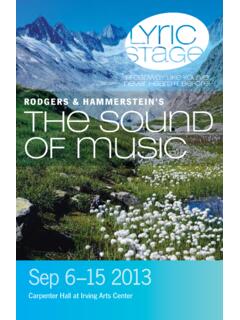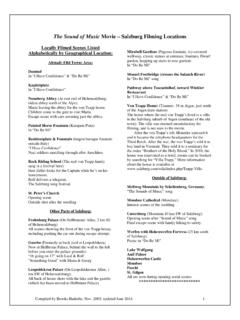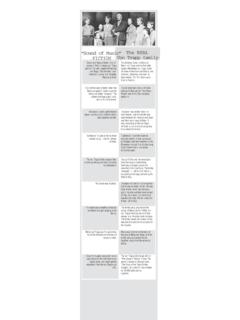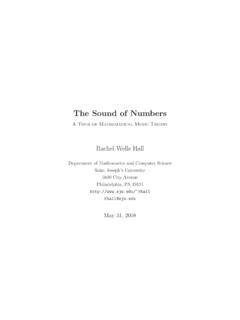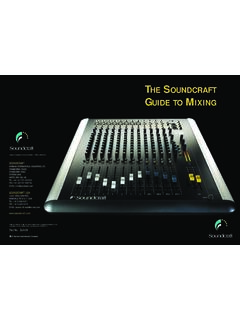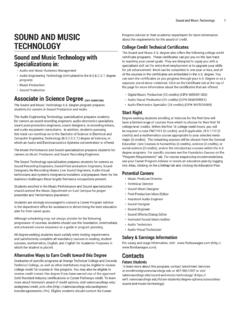Transcription of Psychology and Music - Diana Deutsch
1 Psychology and Music Diana Deutsch University of California, San Diego INTRODUCTION. The relationship between Psychology and Music is characteristic of that between a new science and an established discipline. Western Music theory has a very old tradition, dat- ing at least from the time of Pythagoras; and the philosophical underpinnings of this tra- dition that were established in ancient times still exist today. Most characteristic of this tradition is its rationalism. In contrast with the scientific disciplines, the development of Music theory over the last few hundred years has not been characterized by a growth in the empirical method.
2 Rather, while composers have constantly experimented with new means of expression, Music theorists have on the whole been system builders who sought to justify existing compositional practice or to prescribe new practice on numero- logical grounds. Further, when an external principle has been invoked as an explanato- ry device, most commonly such a principle was taken from physics. The concept of Music as essentially the product of our processing mechanisms and therefore related to Psychology has only rarely been entertained. There are several reasons why this rationalistic stance was adopted, most of which no longer apply.
3 One reason was a paucity of knowledge concerning the nature of sound . It is understandable that the inability to characterize a physical stimulus should have inhibited the development of theories concerning how this stimulus is processed. A. related reason was poor stimulus control, which made experimentation difficult. A third reason was the lack of appropriate mathematical techniques with which to study proba- bilistic phenomena. However, another reason, which is still with us today, lies in the peculiar nature of Music itself. There are no external criteria for distinguishing between Music and nonmusic, or between good Music and bad Music .
4 Further, it is clear that how we perceive Music depends at least to some extent on prior experience. Thus the rele- vance of psychological experimentation to Music theory requires careful definition. In this chapter I first review major developments in Music theory from an historical point of view. Following this I explore various issues that are currently being studied both by Music theorists and by psychologists. Finally, I discuss the role of Psychology in Music theory. HISTORICAL PERSPECTIVE. Speculations concerning Music may be traced back to very ancient times (Hunt, 1978), but the foundations of Western Music theory are generally held to have been laid by Pythagoras (ca.)
5 570-497 ). Pythagoras was concerned mostly with the study of musi- 1. In: M. H. Bornstein (Ed.) Psychology and its Allied Disciplines. Hillsdale: Erlbaum, 1984, 155-194. 2 Deutsch . cal intervals. He is credited with identifying the musical consonances of the octave, fifth, and fourth with the numerical ratios 1:2, 2:3, and 3:4. He is also credited with establish- ing by experiment that the pitch of a vibrating string varies inversely with its length. However, Pythagoras and his followers ultimately lost faith in the empirical method and instead attempted to explain all musical phenomena purely in terms of numerical rela- tionships.
6 As Anaxagoras (ca. 499-428 ) declared: Through the weakness of the sense-perceptions we cannot judge truth [Freeman, 1948, p. 86]. And later Boethius, the leading Music theorist of the Middle Ages and a strong follower of Pythagoras, wrote in De Institutione Musica: For what need is there of speaking further concerning the error of the senses when this same fac- ulty of sensing is neither equal in all men, nor at all times equal within the same man? Therefore anyone vainly puts his trust in a changing judgement since he aspires to seek the truth [Boethius, 1967, p.]
7 58]. The view that Music ought to be investigated solely by contemplation of numerical relationships has characterized most Music theory since Pythagorean times. On this view, the world of mathematics is held to provide an ideal which the world of sense-per- ception can only imitate. Experimental procedures are therefore held to be irrelevant: if the results of experiments are in accordance with theory, then they are redundant; if the results conflict with theory, then they must have been ill-conceived in the first place. Also stemming from the mathematical approach of the Pythagoreans have been the numerous attempts to build entire musical systems by mathematical deduction from a minimal number of established musical facts.
8 Essentially this approach derives from a false analogy with geometry (Russell, 1945). Euclidean geometry begins with a few axioms which are held to be self-evident, and from these axioms arrives by deduction at theorems that are not in themselves self-evident. However, it is a logical error to assume that we can proceed by deduction from one musical fact to another musical fact. Properly, musical facts can only be used as a basis for the formulation of hypotheses about further musical facts, which require empirical verification. Another strong influence on Music theory which stemmed from the Pythagoreans was the belief that the ultimate explanation of musical phenomena lies in physics.
9 Until the Copernican revolution, this belief took the form of assuming that Music serves as a reflection of sounds produced by the heavenly bodies. As described by Aristotle in De Caelo, it was thought: that the motion of bodies of that [astronomical] size must produce a noise, since on our earth the motion of bodies far inferior in size and in speed of movement has that effect. Also, when the sun and the moon, they say, and all the stars, so great in number and size, are moving with so rapid a motion, how should they not produce a sound immensely great? Starting form this argument, and from the observation that their speeds, as measured by their distances, are in the same ratio as musical concordances, they assert that the sound given forth by the circular movement of the stars is a harmony [Aristotle, 1930, ].
10 Figure 1 shows that Pythagorean view of the universe, in which the relative distances of the heavenly bodies to each other are displayed, together with the musical intervals formed thereby. It can be seen that the distance between the Earth and the Moon formed Psychology AND Music 3. a whole tone, from the Moon to Mercury a semitone, from Mercury to Venus a semitone, from Venus to the Sun a tone and a half, from the Sun to Mars a whole tone, from Mars to Jupiter a semitone, from Jupiter to Saturn a semitone, and finally from Saturn to the Supreme Heaven, a semitone.


